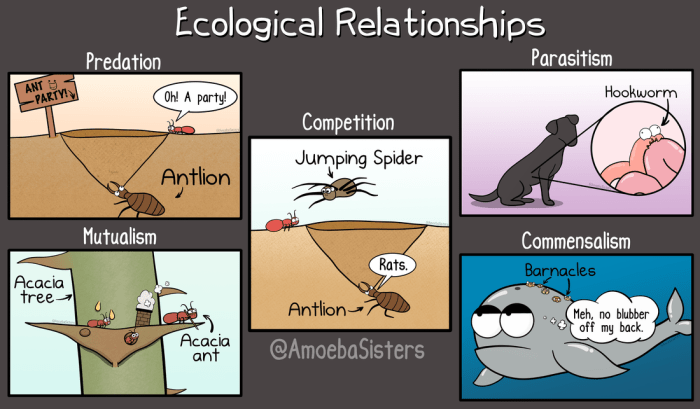Embark on an educational journey with our comprehensive Amoeba Sisters Ecological Relationships Answer Key. This guide delves into the intricate web of interactions between amoebas and their environment, unraveling the fascinating dynamics that shape their existence.
Discover the diverse types of ecological relationships, from commensalism and mutualism to parasitism, and explore how these associations influence the survival and evolution of amoebas. Gain insights into the role of amoebas in food webs and food chains, understanding their ecological significance and the delicate balance they maintain within ecosystems.
Amoeba Sisters Ecological Relationships

Ecological relationships are interactions between living organisms in an ecosystem. These relationships can be positive, negative, or neutral. Amoebas, single-celled organisms, are involved in a variety of ecological relationships with other organisms.
Types of Ecological Relationships
There are three main types of ecological relationships:
- Commensalism: One organism benefits from the relationship while the other is unaffected.
- Mutualism: Both organisms benefit from the relationship.
- Parasitism: One organism benefits at the expense of the other.
Food Webs and Food Chains, Amoeba sisters ecological relationships answer key
Amoebas are part of food webs and food chains. They are consumers that feed on bacteria and other microorganisms. In turn, amoebas are preyed upon by larger organisms, such as water fleas and fish.
Symbiotic Relationships
Symbiotic relationships are close relationships between two or more organisms. Amoebas can form symbiotic relationships with bacteria, fungi, and other microorganisms. These relationships can be mutualistic, commensalistic, or parasitic.
Case Study: Amoeba Sisters and Bacteria
Amoeba sisters are known to prey on bacteria. This relationship is important because it helps to control bacterial populations. However, some bacteria have evolved to be resistant to amoeba sisters, which can lead to disease in humans and other animals.
Query Resolution: Amoeba Sisters Ecological Relationships Answer Key
What is the significance of amoebas in ecological relationships?
Amoebas play crucial roles in ecosystems as consumers, decomposers, and regulators of microbial populations.
How do amoebas benefit from symbiotic relationships?
Symbiotic relationships can provide amoebas with protection, nutrients, and increased access to resources.
What are the potential drawbacks of symbiotic relationships for amoebas?
Some symbiotic relationships can lead to competition for resources, transmission of diseases, or even exploitation by the partner organism.

